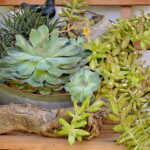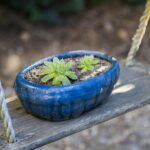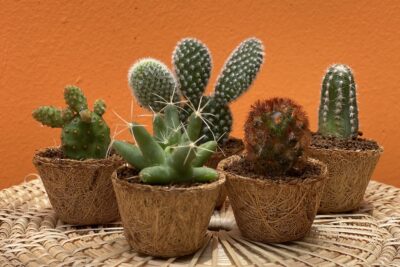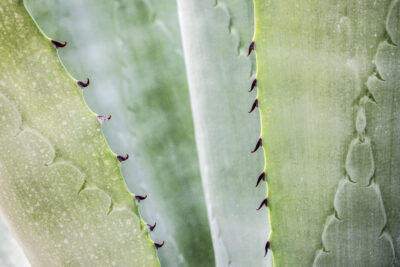
Can You Mist Succulents Every Day? What You Need to Know

Succulents have become increasingly popular in recent years, thanks to their unique and low-maintenance nature. These plants are known for their ability to store water in their leaves, stems, and roots, allowing them to survive in dry and arid environments. However, there is some debate among succulent enthusiasts about whether or not it is necessary to mist these plants every day. Understanding the proper care and watering techniques for succulents is crucial to ensure their health and longevity.
We will explore the topic of misting succulents and whether or not it should be done on a daily basis. We will discuss the natural habitat of succulents and how they have adapted to survive in dry conditions. Additionally, we will delve into the importance of proper watering techniques, including the frequency and methods of watering succulents. By the end of this article, you will have a better understanding of how to care for your succulents and whether or not misting should be a part of your routine.
- No, misting succulents every day is not recommended
- Succulents are adapted to dry environments and do not require frequent misting
- Over-misting can lead to root rot and other issues
- It is best to water succulents sparingly, allowing the soil to dry out between waterings
- Instead of misting, consider using a spray bottle to lightly water the soil around the succulents
- Pay attention to the signs of underwatering or overwatering to adjust your watering schedule accordingly
- Provide proper drainage for your succulents to prevent waterlogged soil
- In addition to watering, succulents also need adequate sunlight and proper air circulation
- If you live in a dry climate, you may need to mist your succulents occasionally during the hottest months, but still be cautious with the frequency
- Always observe your succulents and adjust your care routine based on their specific needs
- Frequently Asked Questions
No, misting succulents every day is not recommended
While misting houseplants is a common practice, it is not advisable to mist succulents every day. Succulents are unique plants that have adapted to survive in arid conditions with minimal water availability. Their thick, fleshy leaves and stems store water, allowing them to withstand drought-like situations.
When you mist succulents every day, you risk overwatering them, which can lead to root rot and other issues. Overwatering can cause the roots to become saturated, leading to oxygen deprivation and ultimately the death of the plant.
Instead of misting your succulents daily, it is important to understand their watering needs and follow a proper watering schedule. Succulents generally prefer infrequent but deep watering. This means that you should thoroughly soak the soil when watering and then allow it to dry out completely before watering again.
How often should you water succulents?
The frequency of watering succulents depends on various factors, including the type of succulent, the climate, and the growing conditions. As a general rule of thumb, most succulents thrive when watered every 1-2 weeks. However, it is crucial to observe your plants and adjust the watering schedule accordingly.
Here are some signs that indicate it's time to water your succulents:
 Epsom Salt for Succulent Plants: A Complete Guide
Epsom Salt for Succulent Plants: A Complete Guide- The leaves appear wrinkled or shriveled
- The soil feels completely dry
- The plant starts to show signs of dehydration, such as wilting or discoloration
On the other hand, if the leaves appear plump and the soil is still moist, it is better to hold off on watering and give the plant more time to dry out.
Proper watering techniques for succulents
When it's time to water your succulents, it is essential to do it correctly to prevent overwatering. Here are some tips:
- Water the soil, not the leaves: Direct the water towards the base of the plant, avoiding the leaves. Wet leaves can create a damp environment, which can lead to fungal diseases.
- Use well-draining soil: Succulents prefer a fast-draining soil mix that allows excess water to escape. Consider using a specialized succulent or cactus soil mix.
- Water thoroughly: Ensure that water reaches the root zone by watering until it starts to drain out of the drainage holes at the bottom of the pot.
- Allow the soil to dry out completely: Succulents prefer dry soil between watering sessions. Wait until the soil is completely dry before watering again.
By following these watering guidelines and avoiding daily misting, you can provide your succulents with the right amount of moisture they need to thrive.
Remember, less is more when it comes to watering succulents!
Succulents are adapted to dry environments and do not require frequent misting
Succulents are unique plants that have evolved to thrive in arid conditions. Their thick, fleshy leaves and stems allow them to store water, making them highly resilient to drought. Due to their water storage capabilities, succulents do not require frequent misting like other houseplants.
Why misting can be detrimental to succulents
 Is It Normal for My Succulent to Have an Unusual Growth?
Is It Normal for My Succulent to Have an Unusual Growth?Misting succulents every day can actually harm them. When water droplets sit on the leaves for extended periods, it can lead to the development of fungal diseases, such as rot. Excessive moisture can also cause the roots to become waterlogged, leading to root rot and eventual death of the plant.
How often should you mist succulents?
The frequency of misting succulents depends on various factors, including the climate, humidity levels, and the type of succulent. In general, it is best to err on the side of caution and mist sparingly. For most succulents, misting once every 2-3 weeks is sufficient. However, it is crucial to observe the moisture level of the soil and the overall health of the plant to determine when misting is necessary.
Alternative ways to provide moisture to succulents
If you want to provide some moisture to your succulents without misting, there are alternative methods you can try:
- Bottom watering: Place the pot in a tray of water and allow the plant to soak up the water through the drainage holes. This ensures that the roots receive moisture without the risk of overwatering.
- Using a spray bottle: Instead of misting, you can use a spray bottle to lightly water the soil around the base of the succulent. This helps avoid excessive moisture on the leaves while providing hydration to the plant.
- Watering from below: Fill a dish or saucer with water and place the pot on top, allowing the plant to absorb water from the bottom. This method ensures that the roots receive water while minimizing moisture on the leaves.
Conclusion
Succulents do not require daily misting due to their water storage capabilities. Over-misting can lead to fungal diseases and root rot. It is best to mist sparingly, once every 2-3 weeks, or use alternative methods like bottom watering or watering from below to provide moisture to your succulents without risking their health. Remember to always observe the moisture level of the soil and the overall health of the plant to determine the ideal watering routine for your succulents.
 Can Succulents Die from Overwatering and Lack of Sunlight?
Can Succulents Die from Overwatering and Lack of Sunlight?Over-misting can lead to root rot and other issues
When it comes to caring for succulents, it's important to strike the right balance in terms of watering. While these plants are known for their ability to tolerate drought, they still require some water to thrive. One common question that succulent enthusiasts often ask is whether it's okay to mist succulents every day.
The short answer is no. Over-misting succulents can actually do more harm than good. These plants have adapted to survive in arid environments by storing water in their leaves and stems. When you mist them too frequently, you run the risk of introducing excess moisture to the plant, which can lead to a variety of issues.
Potential Problems of over-misting succulents
- Root rot: Excess moisture can cause the roots to become waterlogged, leading to root rot. This condition is characterized by dark, mushy roots and can ultimately kill the plant.
- Edema: Over-misting can also result in edema, which is the formation of small blisters or corky patches on the leaves. These blisters occur when the plant cells expand due to the intake of excess water. Edema can make the leaves appear swollen and can eventually lead to tissue damage.
- Fungal and bacterial diseases: Constant moisture on the leaves and stems of succulents can create a favorable environment for the growth of fungal and bacterial diseases. These diseases can cause discoloration, spotting, or even decay of the plant.
- Weak growth: Over time, over-misting can weaken the overall growth of succulents. These plants are designed to withstand periods of drought, and excessive watering can disrupt their natural growth patterns.
Instead of misting your succulents every day, it's best to adopt a watering routine that mimics their natural habitat. Succulents generally prefer infrequent, deep watering rather than frequent, shallow watering. Allow the soil to dry out completely between waterings and then give the plant a thorough soak.
If you're concerned about providing enough humidity for your succulents, you can place a tray of water near the plants or use a humidifier to increase the moisture in the air. This indirect method of providing humidity is much safer than misting directly on the plants.
While it may be tempting to mist your succulents every day, it's important to resist the urge. Over-misting can lead to root rot, edema, fungal and bacterial diseases, and weak growth. Instead, opt for a watering routine that allows the soil to dry out between waterings, and provide indirect humidity through other means.
It is best to water succulents sparingly, allowing the soil to dry out between waterings
When it comes to caring for succulents, one of the most common questions is whether or not you can mist them every day. While it may seem like a good idea to provide these water-storing plants with a daily dose of moisture, it is actually best to water succulents sparingly.
 Trimming Succulents: Can I Safely Prune the Top of an Overgrown Plant?
Trimming Succulents: Can I Safely Prune the Top of an Overgrown Plant?Succulents are known for their ability to survive in arid conditions, and overwatering can be detrimental to their health. These plants have adapted to store water in their leaves, stems, and roots, allowing them to withstand long periods of drought. Therefore, it is important to allow the soil to dry out between waterings.
Why should you avoid misting succulents every day?
1. Root rot: Succulents are prone to root rot, especially if they are constantly exposed to moisture. Overwatering or misting them every day can lead to soggy soil, which creates the perfect environment for root rot to develop. Root rot occurs when the roots of the succulent become waterlogged, causing them to decay and eventually die.
2. Lack of oxygen: Overwatering can also lead to a lack of oxygen in the soil. Succulent roots need oxygen to function properly, and when the soil is constantly wet, it becomes compacted and oxygen cannot reach the roots. This can cause root suffocation and eventually lead to the death of the plant.
3. Weak growth: Regular misting or overwatering can result in weak and leggy growth in succulents. When succulents receive too much water, they tend to stretch out in search of more light, resulting in elongated stems and weak foliage. This can detract from the natural beauty and compact form of the succulent.
How often should you water succulents?
Instead of misting succulents every day, it is recommended to water them sparingly. The frequency of watering will depend on various factors such as the type of succulent, the size of the pot, and the environmental conditions. As a general rule of thumb, it is best to wait until the soil is completely dry before watering again.
One way to determine if your succulents need water is to check the moisture level of the soil. Stick your finger about an inch into the soil and if it feels dry, it's time to water. Alternatively, you can use a moisture meter to accurately measure the moisture content of the soil.
Remember, it is always better to underwater succulents than to overwater them. These resilient plants can tolerate periods of drought, but they cannot recover from root rot caused by excessive moisture. By watering them sparingly and allowing the soil to dry out between waterings, you can ensure the health and longevity of your succulents.
 Can Succulents Survive a Freeze Unprotected?
Can Succulents Survive a Freeze Unprotected?Instead of misting, consider using a spray bottle to lightly water the soil around the succulents
Misting succulents every day may seem like a good idea to keep them hydrated, but it's important to understand the specific needs of these plants. While succulents are known for their ability to store water in their leaves, misting them excessively can actually do more harm than good.
Why is misting not recommended for succulents?
Misting succulents every day can lead to overwatering, which is one of the most common causes of succulent death. Succulents have adapted to survive in arid climates where water is scarce, so they are not accustomed to frequent watering.
When you mist succulents, the water droplets sit on their leaves for an extended period, preventing the leaves from drying out properly. This creates a moist environment that promotes the growth of fungus and bacteria, which can lead to root rot and other diseases.
What should you do instead?
Instead of misting your succulents every day, it's better to water them sparingly but thoroughly. Use a spray bottle to lightly water the soil around the succulents, making sure to avoid wetting the leaves. This mimics the natural rainfall these plants would receive in their native habitats.
 Protecting Succulents: Tips for Cold Weather Survival
Protecting Succulents: Tips for Cold Weather SurvivalWhen watering your succulents, make sure to allow the soil to dry out completely between waterings. Succulents prefer well-draining soil, so it's essential to use a potting mix specifically formulated for these plants.
How often should you water succulents?
The frequency of watering succulents depends on various factors, such as the climate, humidity levels, and the type of succulent you have. As a general rule of thumb, it's best to water your succulents when the top inch of soil is dry. This may be every 1-2 weeks, but it can vary.
Remember that it's always better to underwater than to overwater succulents. They are more likely to survive in dry conditions than in overly moist ones.
Conclusion
Misting succulents every day is not recommended as it can lead to overwatering and the development of diseases. Instead, opt for lightly watering the soil around the succulents and allowing it to dry out completely between waterings. By understanding the specific watering needs of succulents, you can help them thrive and enjoy their unique beauty for years to come.
Pay attention to the signs of underwatering or overwatering to adjust your watering schedule accordingly
 Using Regular Miracle Gro Fertilizer: Is it Suitable for Succulents?
Using Regular Miracle Gro Fertilizer: Is it Suitable for Succulents?When it comes to succulents, finding the right balance of water is crucial for their health and longevity. While succulents are known for their ability to withstand drought-like conditions, they still require some watering to thrive. One common question that succulent enthusiasts often ask is, "Can you mist succulents every day?"
The short answer is no, you should not mist your succulents every day. Succulents are adapted to arid environments where water is scarce. Overwatering can lead to root rot and other fungal diseases that can quickly kill your beloved succulents.
Pay attention to the signs of underwatering or overwatering
Instead of misting your succulents daily, it is important to pay attention to the signs of underwatering or overwatering. Underwatering can cause the leaves to become shriveled and wrinkled, while overwatering can lead to yellowing leaves, mushy stems, and a foul smell.
One way to determine when it's time to water your succulents is by checking the soil moisture. Stick your finger into the soil about an inch deep. If it feels dry, it's time to water. However, if it still feels moist, it's best to wait a few more days before watering.
Adjust your watering schedule accordingly
Instead of misting your succulents daily, opt for a thorough watering once every 1-2 weeks, depending on the climate and the specific needs of your succulents. When watering, make sure to soak the soil evenly until water drains out of the drainage holes at the bottom of the pot. This ensures that the roots receive enough water without sitting in stagnant moisture.
During hot summer months or if your succulents are placed in a particularly dry environment, you may need to increase the frequency of watering. However, always keep in mind that it's better to underwater than to overwater your succulents.
Remember: Succulents are built to store water in their leaves, stems, and roots. They are more likely to survive underwatering than overwatering. So, it's always a good idea to err on the side of caution and water your succulents less frequently rather than too often.
 Succulent Care on Wood: A Guide to Proper Maintenance
Succulent Care on Wood: A Guide to Proper MaintenanceMisting your succulents every day is not recommended. Pay attention to the signs of underwatering or overwatering, adjust your watering schedule accordingly, and always prioritize the well-being of your succulents over excessive moisture.
Provide proper drainage for your succulents to prevent waterlogged soil
If you are a succulent enthusiast, you might find yourself wondering if it is necessary to mist your succulents every day. While misting can be beneficial for some plants, succulents have unique water requirements that need to be taken into consideration.
One of the most crucial factors to keep in mind when caring for succulents is proper drainage. Succulents thrive in well-draining soil, as their roots are susceptible to rotting if exposed to excessive moisture. Therefore, it is essential to ensure that your succulents are planted in a well-draining potting mix and that their containers have adequate drainage holes.
Misting your succulents every day can lead to waterlogged soil, which can be detrimental to their health. When water accumulates at the bottom of the pot or remains trapped in the soil, it can cause the roots to rot and lead to the onset of root diseases. This can ultimately result in the death of your succulents.
Instead of misting your succulents daily, it is best to water them deeply but infrequently. Succulents are adapted to survive in arid environments, and they store water in their leaves and stems. Therefore, they prefer to be watered thoroughly and then allowed to dry out before the next watering session.
When watering your succulents, make sure to drench the soil until water begins to flow out of the drainage holes. This ensures that the roots receive enough moisture without the risk of overwatering. After watering, allow the soil to dry completely before watering again.
 Reviving an Overwatered Succulent: Tips to Save Your Plant
Reviving an Overwatered Succulent: Tips to Save Your PlantFurthermore, it is worth noting that misting may not provide adequate hydration for succulents, as the water droplets may evaporate before being absorbed by the plant. Instead, focus on watering the soil directly, ensuring that it is evenly moist but not soggy.
Misting your succulents every day is not recommended. Proper drainage is key to preventing waterlogged soil and root rot. Water your succulents deeply but infrequently, allowing the soil to dry out between waterings. By following these guidelines, you can ensure the health and longevity of your beloved succulents.
In addition to watering, succulents also need adequate sunlight and proper air circulation
When it comes to caring for succulents, watering is often the first thing that comes to mind. However, it's important to remember that these plants also require adequate sunlight and proper air circulation to thrive.
Succulents are known for their ability to store water in their leaves, stems, and roots, which allows them to survive in arid conditions. While they are drought-tolerant, they still need some moisture to grow and remain healthy. But how often should you mist your succulents?
Understanding the needs of succulents
Succulents come in various shapes and sizes, but they all share the same basic requirements. They thrive in bright, indirect sunlight and require well-draining soil to prevent root rot. Additionally, succulents benefit from good air circulation to prevent fungal diseases.
When it comes to watering, succulents prefer to be watered deeply but infrequently. This means that instead of misting them every day, it's better to water them thoroughly and then allow the soil to dry out before watering again. Overwatering can lead to root rot and other issues, so it's important to find the right balance.
The role of misting in succulent care
Misting can be a useful tool in succulent care, but it should not be the main method of watering. Misting can help provide a boost of moisture to the leaves and stems, especially in dry environments or during the winter months when indoor heating can cause dry air. However, it's important to mist sparingly and avoid getting the leaves too wet, as this can lead to rot.
 Succulent Care: Pruning Damaged Leaves
Succulent Care: Pruning Damaged LeavesInstead of relying solely on misting, it's best to water your succulents at the soil level. This allows the roots to absorb the water they need while avoiding excess moisture on the leaves. A thorough watering once every 1-2 weeks, depending on the climate, is usually sufficient for most succulents.
Signs of overwatering or underwatering
Proper watering is crucial for the health of your succulents. Overwatering can cause the roots to rot, resulting in wilting, yellowing leaves, and a mushy texture. On the other hand, underwatering can lead to shriveled, drooping leaves and a lack of growth.
Observing your succulents closely is key to determining their watering needs. If the leaves feel firm and plump, it's a sign that they have sufficient water. However, if the leaves appear wrinkled or start to turn brown, it's a sign that they need more moisture.
Remember, each succulent variety may have slightly different watering requirements, so it's important to do your research and adjust your watering routine accordingly. By understanding the needs of your succulents and providing them with the right amount of water, sunlight, and air circulation, you can help them thrive and enjoy their unique beauty.
If you live in a dry climate, you may need to mist your succulents occasionally during the hottest months, but still be cautious with the frequency
Succulents are known for their ability to store water in their leaves and stems, making them resilient in dry climates. However, extreme heat can sometimes cause these plants to lose moisture faster than they can replenish it. This is where misting your succulents comes into play.
Misting involves spraying a fine mist of water onto the leaves and stems of your succulents. It can provide a quick burst of hydration to the plants, helping them survive during hot and dry periods.
How often should you mist your succulents?
While misting can be beneficial, it's important not to overdo it. Succulents are adapted to survive with minimal water, and excessive moisture can lead to root rot and other issues.
As a general rule of thumb, you should only mist your succulents during the hottest months or when you notice signs of dehydration, such as shriveled leaves or a dry potting mix. In most cases, once or twice a week should be sufficient.
However, it's crucial to consider the specific needs of each succulent variety. Some types, like the desert-dwelling cacti, require even less frequent misting, while others may benefit from more regular watering. Research the care requirements of your specific succulent species to ensure you provide the right amount of moisture.
How to mist your succulents effectively
To mist your succulents effectively, follow these guidelines:
- Use a spray bottle: Fill a clean spray bottle with filtered or distilled water. Avoid using tap water, as the minerals can leave residue on the leaves.
- Mist from a distance: Hold the spray bottle at least 6 inches away from the succulent and mist the leaves and stems using a fine mist setting. Avoid soaking the plant or creating puddles of water.
- Time it right: Misting your succulents in the early morning or late afternoon is ideal. This allows any excess moisture to evaporate before cooler evening temperatures, reducing the risk of fungal diseases.
- Observe your plants: Keep an eye on your succulents after misting. If you notice any signs of overwatering, such as yellowing leaves or mushy stems, adjust your misting frequency accordingly.
Remember, misting should not replace regular watering. Succulents still require a thorough soak when their potting mix is dry. Misting is just an additional method to provide temporary hydration during hot and dry periods.
By understanding the needs of your succulents and misting them appropriately, you can help them thrive in challenging weather conditions and maintain their beautiful and healthy appearance.
Always observe your succulents and adjust your care routine based on their specific needs
Succulents are known for their ability to store water in their leaves, stems, and roots, making them low-maintenance plants that are ideal for busy individuals or those with a less-than-green thumb. However, it is important to remember that not all succulents are created equal, and their watering needs can vary.
One common question among succulent enthusiasts is whether it is necessary to mist their plants every day. The answer to this question depends on various factors, such as the type of succulent, humidity levels, and the climate in which they are kept.
Understanding the Watering Needs of Succulents
Succulents, in general, do not require frequent watering like other houseplants. They have adapted to survive in arid environments, where water is scarce. Overwatering can lead to root rot and other issues, so it is crucial to strike a balance.
Instead of misting your succulents every day, it is best to follow a "soak and dry" watering method. This means thoroughly watering the soil until it is completely saturated and then allowing it to dry out completely before watering again. The frequency of watering will depend on the specific succulent and its needs.
When it comes to misting succulents, it can be beneficial in certain situations. Misting can provide additional moisture during dry spells or in environments with low humidity. It can also be helpful for propagating succulents or when you want to clean the leaves and remove dust.
Factors to Consider
While misting can be beneficial, it is important to consider a few factors before incorporating it into your succulent care routine:
- Type of Succulent: Some succulents, like the Haworthia or Aloe Vera, prefer drier conditions and may not require misting at all. On the other hand, certain succulents, such as the String of Pearls or Burro's Tail, appreciate some extra humidity and can benefit from occasional misting.
- Humidity Levels: If you live in a region with high humidity, misting may not be necessary as the air already contains sufficient moisture for your succulents. However, if you reside in a dry climate or during winter when indoor heating reduces humidity, misting can help supplement moisture levels.
- Seasonal Changes: Succulents, like many other plants, have different watering needs depending on the season. During the active growing season (usually spring and summer), succulents may require more frequent misting or watering. In contrast, during the dormant period (usually fall and winter), they require less moisture.
Misting succulents can be a useful tool in your plant care routine, but it should not replace proper watering techniques. Always prioritize the "soak and dry" method, adjusting the frequency based on your succulents' specific needs. Take into account the type of succulent, humidity levels, and seasonal changes to ensure your plants thrive. Remember, observing your succulents and adapting your care routine accordingly is key to their overall health and longevity.
Frequently Asked Questions
1. Can you mist succulents every day?
No, it is not recommended to mist succulents every day. Overwatering can lead to root rot and other issues. Succulents prefer dry conditions and only need to be watered when the soil is completely dry.
2. How often should I water my succulents?
The frequency of watering depends on various factors such as the type of succulent, climate, and potting mix. In general, succulents should be watered every 1-2 weeks, allowing the soil to dry out completely between waterings.
3. Can I use a spray bottle to water my succulents?
Yes, a spray bottle can be used to water succulents, but it is important to ensure that the water reaches the roots and not just the surface. Directly watering the soil is usually more effective than misting the leaves.
4. How do I know if my succulent needs water?
To determine if your succulent needs water, you can check the moisture level of the soil by inserting your finger about an inch deep. If it feels dry, it's time to water. Alternatively, some succulents may show slight wrinkling or drooping when they need water.
If you want to read more articles similar to Can You Mist Succulents Every Day? What You Need to Know, you can visit the Care and Maintenance category.






You Must Read